Churchill Downs
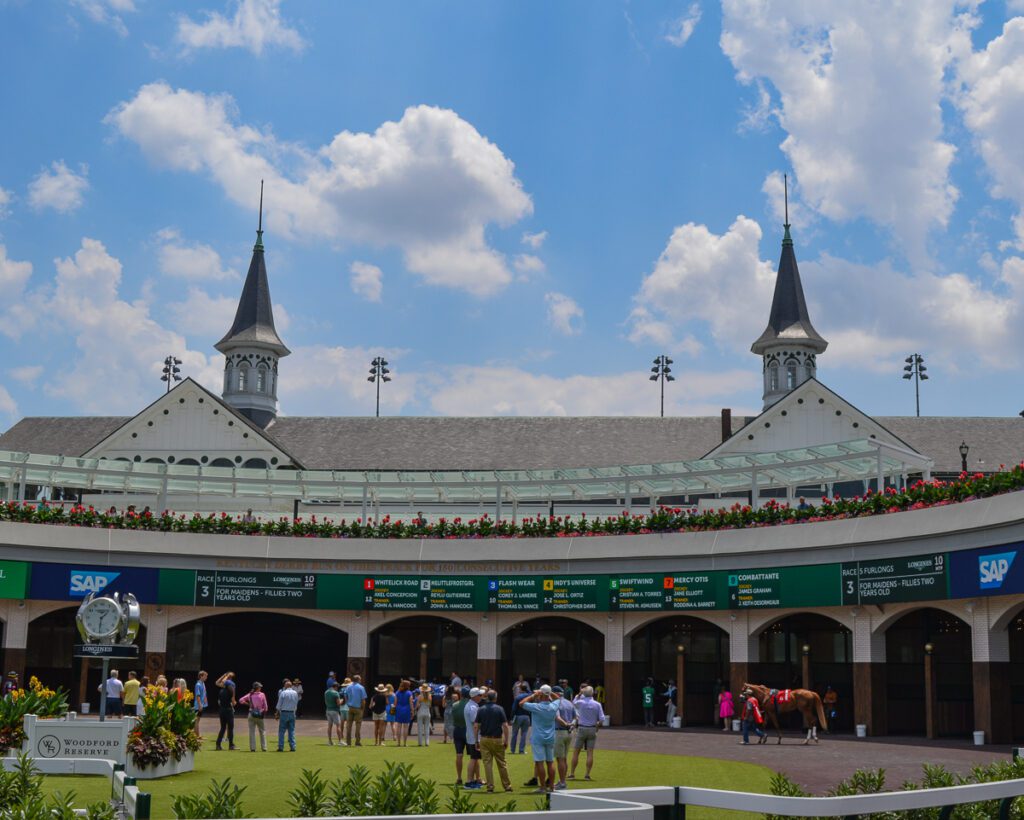
Colonel Meriweather Lewis Clark, Jr., grandson of William Clark of the Lewis and Clark expedition fame, was an avid horse and horserace fan. In 1872, Colonel Clark traveled to England, with his father-in-law Richard Ten Broek, a noted horse breeder and trainer, to watch a series of races, including the Epsom Derby. There, Clark became obsessed with the sport and the idea of bringing that level of racing and excitement to America.
Back home, while conversing with two of his uncles, John and Henry Churchill, his enthusiasm infected the uncles. They liked the idea of a horse venue and agreed to donating eighty acres of land three miles south of downtown Louisville to their nephew, telling Colonel Clark to create that track. Churchill Downs was born. https://www.churchilldowns.com/
Over the next three years, Clark worked tirelessly selling ‘membership subscriptions’. Determined, he sold three hundred and twenty ‘subscriptions’ at $100 each, raising $32,000, enough to construct a racetrack, clubhouse, grandstand and six stables.
Early Times
On May 17, 1875, Churchill Downs officially opened. Numerous races ran that day, but the most important three were the major stakes races, the Kentucky Derby, Kentucky Oaks, and the Clark Handicap. Fashioned after the English races that so enthralled Colonel Clark, the Epsom Derby, Epsom Oaks, and St. Leger Stakes.
Bonaventure is the first horse to ever win a race at Churchill Downs. Time has lost any additional information about this horse.
Not so with Aristides! The featured race of the day was the Kentucky Derby, drawing ten thousand spectators into the crowded clubhouses and grandstands to cheer on the fifteen horses entered.
Owned by H.P. McGrath, Aristides was under the care of two African Americans; trainer Ansel Williamson and jockey Oliver Lewis. This three-year-old chestnut streaked two lengths ahead of his competitors, crossing the finish line in 2:37.75, a world record pace in that era for a mile-and-a-half distance. Aristides won a staggering purse of $2850. Volcano, the second-place Derby finisher made $200 for his owner. Hanging proudly above the Churchill Downs paddock, Aristides’ name is the one equine that will stay forever. Millions have passed his elegant life-sized statue, positioned just inside the gates of the racetrack.
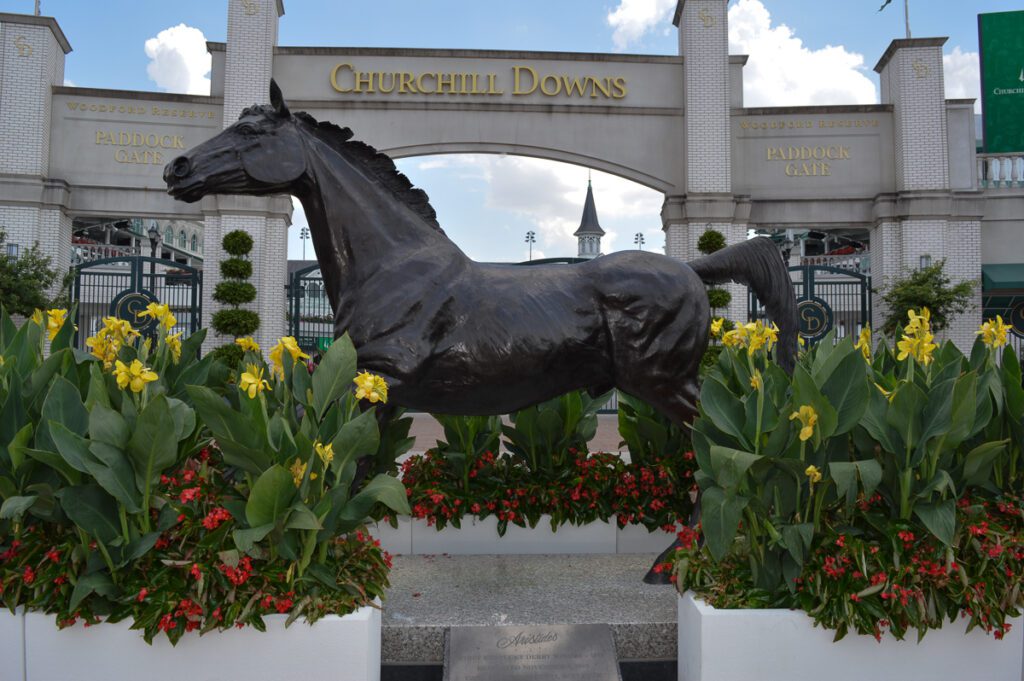
Since 1875, Churchill Downs has been a continual work in progress and an important part of Louisville life. In 1895, a proud new grandstand stood, sporting twin spires on its roof.
During the early 1900’s, a new clubhouse accommodated those coming to watch automobile races, band concerts and steeplechase events. The State Fair took place at Churchill Downs, with the main draw being two locomotives, in the infield, crashing head-on before the masses.
Sometime in 1910, during the early days of aviation, Glenn Curtiss built an airplane in the infield and announced he would fly it over the track. This may have been the first known flight in Kentucky. Curtiss did take off from the infield and gave the crowd a thrilling show. Most of Louisville turned up for the spectacle.
Matt Winn (1861-1949) was a Louisville native consumed by all aspects of racing. A merchant tailor, Winn talked a good friend and client, William E. Applegate, into becoming more involved in the track. His friend was the majority holder of the New Louisville Jockey Club and Winn expected more of him. Understanding this, Applegate did step up his efforts, soon announcing Winn as vice-president of catering and summer entertainment events.
In 1914, Winn became General Manager, a position he held until his death. Considered “the father of the Kentucky Derby”, Winn’s constant goal was to improve the Derby experience, introducing the garland of roses in 1906, the gold cup and the collectable mint julep glass. In 1915, Winn talked Harry Payne Whitney into bringing his elite mare Regret, (1912-1934) from New Jersey to Kentucky to run in the Derby. Whitney was reluctant but agreed. A great amount of noise and attention surrounded a filly entering the race, and it made the ladies of Louisville eager to attend and watch her race the males. Regret ran a memorable race, winning in 2:05, the first undefeated Kentucky Derby horse and women became regulars at the track!
The Matt Winn Stakes runs each May in his honor.
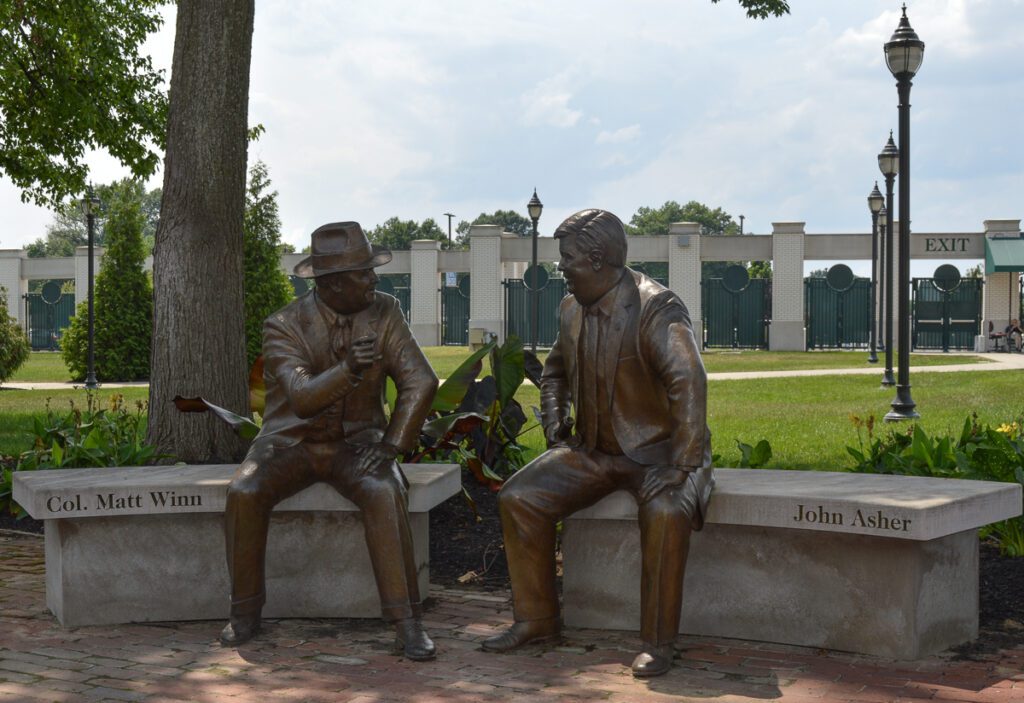
African American Jockeys
Churchill Downs has always honored everyone who has been a part of it, supporting minorities throughout the ages. Many tracks refused to pay or mention winning African American jockeys or trainers in the 1800’s, not so at Churchill Downs. Issac Murphy was one such jockey. Considered by many as the ‘greatest jockey that ever lived’, Murphy was the first jockey to win three Derby’s and the first jockey inducted in the National Museum of Racing Hall of Fame. Murphy’s statue stands opposite Man ‘O War’s at the Kentucky Horse Park near Lexington.
Jimmy Winkfield, another African American, won back-to-back Derby’s in 1901 and 1902.
June 5, 1907, African American jockey James Lee thrilled by winning every race run that day. This feat is a record undefeated to this day. https://www.ebony.com/black-jockeys-were-once-the-backbone-of-the-kentucky-derby-now-theyve-been-all-but-forgotten-over-time/
Historical Events at Churchill Downs
In 1986, Churchill Downs became a National Historic Landmark.
Then 2011 and an EF2 tornado that badly damaged several stables and the chapel. No deaths, but two hundred horses needed relocating.
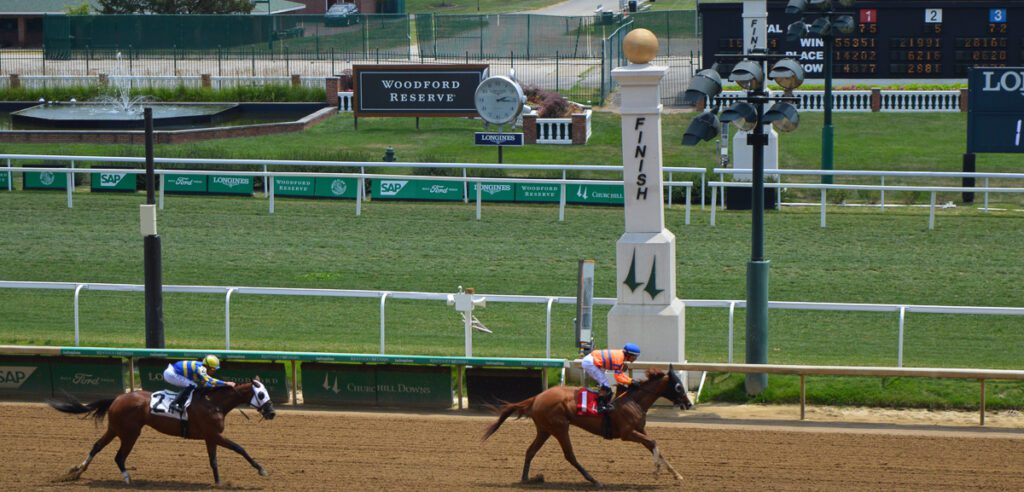
2023 was a sad and puzzling year, as twelve horses needed euthanasia in the weeks before and after the Derby, due to injuries. Two horses died in several of the first races of Derby Day.
Officials investigated every death stringently, banning one trainer who was unfortunate enough to lose two animals. No singular cause could be found. Some horse accidents were on the main track, others on turf.
The Horseracing Integrity and Safety Act (HISA) governs racing. The group became aggressive, insisting the track close until answers were found, and changes made for the better. Most of the remaining season ran at Ellis Park in Henderson, KY.
“You can’t ever be too safe when it comes to our sport,” two-time Derby-winning jockey Mike Smith said.
2023 was already in a major reconstruction of $150 million to ready the track for the 150th Running of the Roses in 2024. Suddenly, additional and more important work demanded attention.
“We take this very seriously and acknowledge that these troubling incidents are alarming and must be addressed,” Churchill Downs said in the statement. “We feel a tremendous responsibility to our fans, the participants in our sport and the entire industry to be a leader in safety and continue to make significant investments to eliminate risk to our athletes.”
“While each incident reported has been unique, it is important to note that there has been no discernible pattern detected in the injuries sustained,” the statement read. “Our track surfaces are closely monitored by industry experts to ensure their integrity. Each horse that participates in racing at Churchill Downs must undergo multiple, comprehensive veterinarian exams and observations to ensure their fitness to race.”
Necropsies and toxicology reports on the horses found no banned substances for any of the horses and reinstated the trainer who lost two horses. HISA made multiple safety recommendations and insisted on more transparent medical records.
Churchill Downs took a thorough look at the track and expanded their equipment to assess track cushioning, formed a safety management group and decided all horses will run with StrideSAFE biometric sensors that should sense a potential injury earlier by spotting inconsistencies in the gait.
New track equipment needed to harrow and grade the surface now has built in testers to help determine safety and consistency of thickness. Track cushioning is continuously measured. Moisture levels are taken throughout racing day, determining areas needing water.
“The track is a lot different than it was. It’s got more sand in it now, it’s got more base, more cushion,” said Hall of Fame trainer D. Wayne Lukas. “It’s quite a bit deeper. Horses are getting over it good.”
Installing an equine diagnostic imaging PET scanner, the second U.S. track to offer this machine, may help.
Today
Churchill Downs stands as one of the country’s premier racetracks. Maybe not in architecture or dazzling gardens or the best weather but because it has endured since 1875. Still in the same location, it possesses a graciousness that is evident every time a horse steps onto the track. Because it has been an enormous part of the nation’s landscape for one-hundred-and-fifty years, redefining racing all that time. The Downs has gracefully led the way other racetracks have followed.
It is a National Historic Landmark which might be a nuisance at times. Remodels must follow strict guidelines. The neighborhood in 1875 was gentrified but is now a working class one with snarled traffic every race day. The seats are up steep stairs in the moderately priced sections and, when crowded, the cheering gets overwhelmingly noisy. The Mint Juleps remain overly sugared.
But that is all part of the thrill of being at Churchill.
There is a certain reverence from the minute one steps through the gates at the Downs. From the mournful and timeless song, My Old Kentucky Home, Good Night, Stephan Foster’s great anti-slavery ballad that is Kentucky’s state song, destined to give every attendee an emotional jolt as horses step onto the field to the parade paddock to the starting gate to the finish line, it is a race lovers thrill. https://www.songhall.org/profile/Stephen_Foster/
The Churchill Downs Museum is an experience that wraps itself around you. Start in the oval theater, for there a thirteen-minute interactive film puts visitors in the action of a Kentucky Derby Day. Beginning with an early morning barn experience, to the arrival of vendors, then visitors, and on to the race itself, this film concentrates on color, action and being there!
For historians and museum lovers, the Churchill Downs Museum is truly exceptional. Sections remain devoted to the inspiring and complicated biographies of famed jockeys and trainers. Horses stay idolized here. One comes away with respect and understanding the incredible work and plain luck needed to make it to the Derby.
Shoppers love the many the gift stores. Everything racing, Kentucky and historical is for sale, from clothing, coasters and books to opulent and ornate hats. All the highest quality.
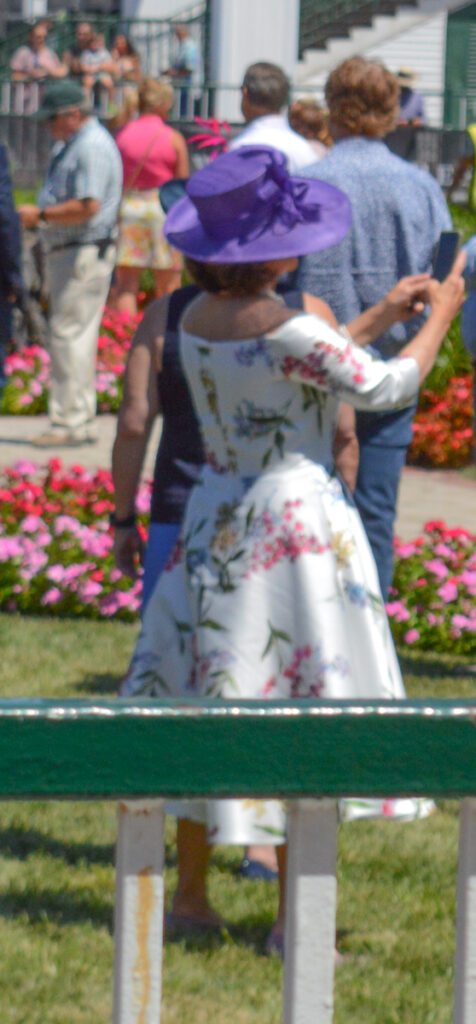
From its humble beginnings in 1875 to today, Churchill Downs now spans one hundred and forty-seven acres. Those Twin Spires are the architectural feature that defines this place, making it a globally recognized symbol for both Churchill Downs and the Kentucky Derby. They are the symbol for one of Kentucky’s most important places and one that has kept the state at the cutting edge of racing since the beginning.
A day at Churchill Downs is pure pleasure. If you are a racing fan, you know what that means.